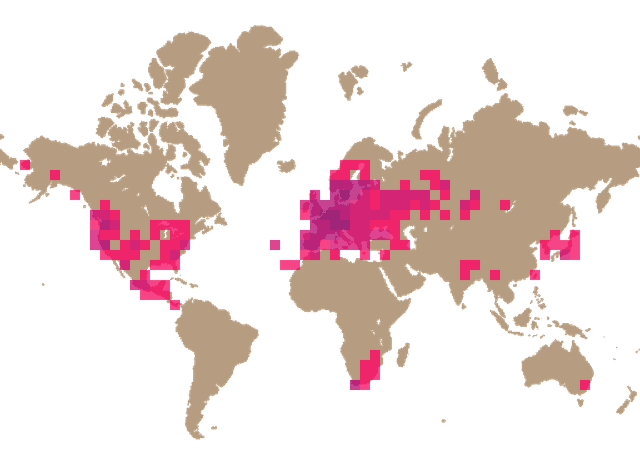This mushroom has a brown cap with white spots, white gills, and a often more than one ring on its stem. It is found in temperate regions across Europe, North America, and Asia, typically in coniferous and mixed forests, forming mycorrhizal relationships with trees. Its consumption is extremely dangerous due to its potent neurotoxins, which cause severe symptoms such as hallucinations, convulsions, and potentially fatal effects.
The cap is 5-18 cm (2-7 in) in diameter. Initially dome-shaped, it flattens with age, sometimes cracking at the edges. The surface is dry and shiny, becoming sticky when wet. Its color ranges from dull brown to bronze and yellowish-brown, with the center sometimes darker. The cap is covered with small white or slightly brownish scales or patches, which are remnants of the veil. The edge typically shows fine radial lines and also may have white veil remnants.
The gills usually are free from the stem and soft. When the mushroom is mature and the cap has flattened, they can appear quite large and may protrude from under the cap. Additionally, they can become wavy. Initially white, they can turn yellowish or creamy with age. Upon closer inspection, the edges of the gills are slightly serrated.
The stem is 6-13 cm (2.5-5 in), white. It may become hollow with age. The surface is often smoother above the ring and more fibrous or scaly below. The base is thickened and bulbous, with a distinct rim formed by a separated fragment of the volva. Sometimes there are multiple encircling rings, or they may break into numerous irregularly placed scales.
The flesh is white, sometimes yellowish just beneath the cap's surface. Since the appearance of the flesh is not a crucial diagnostic feature, if other characteristics suggest it might be A. pantherina, it's best not to test it. Avoid contaminating your knife and hands, as this mushroom is very poisonous.
The ring is white. Initially thick, looking like a hoop, it becomes thinner and more pendulous over time, and may eventually fall off completely. The edge is sometimes serrated. The surface is smooth, without striations. In older fruiting bodies or during very dry weather, the surface may become uneven and wrinkled but will never develop lines.
White or creamy. It may be intact on young fruiting bodies, but later it usually breaks apart, forming complete rings or ridges on the thickened stem base. These can also appear as separate scales arranged in rings, spirals, or sometimes chaotically.
Solitary or in small groups.
The spore print is white.
It forms mycorrhiza with trees, so it is found in forests, both coniferous and mixed.
It has no noticeable smell, but if you bruise the flesh, it may resemble the scent of radish, raw potatoes or turnip. Some describe this odor as sour and unpleasant. However, it is best not to test this, and under no circumstances should you taste it, as the mushroom is deadly poisonous.
Amanita pantherina is highly toxic and dangerous to consume. It contains potent toxins, which affect the central nervous system. Ingesting this mushroom can lead to severe symptoms including nausea, vomiting, diarrhea, hallucinations, convulsions, and in extreme cases, coma or death.
Among the Amanita species, few are considered safe to eat, so it's wise to avoid any mushrooms resembling Amanitas. However, there is at least one species that can be consumed after thorough cooking. Here’s how to distinguish it from the deadly Panther cap:
The Blusher has fine lines on the ring, whereas the Panther сap's ring surface is smooth or wrinkled when dry, but never has radial lines.
As the Blusher ages, only a swollen stem base remains instead of a volva. In contrast, the Panther сap retains a volva and has characteristic encircling rings above it.
The surface and flesh of the Blusher redden when bruised or exposed to air, while the Panther сap does not.
- Foraging for mushrooms and other wild foods in the UK (2024) Wild Food UK. Available at: https://www.wildfooduk.com/ (Accessed: 26 June 2024).
- Jordan, P. (2012) The Mushroom Guide and Identifier: The Ultimate Guide to identifying, picking and using mushrooms. Leicestershire: Hermes House, an imprint of Anness Publishing Ltd.
- Laessøe, T. (2013) Mushrooms: How to identify and gather wild mushrooms and other fungi. New York: DK.
- McIlvaine, C., Macadam, R.K. and Millsquash, C.F. (1912) Toadstools, mushrooms, fungi, edible and poisonous and one thousand American fungi. Indianapolis: The Bobbs-Merrill Company.
- McKnight, K.H. and McKnight, V.B. (1987) A field guide to Mushrooms of North America. Boston: Houghton Mifflin.
- Your 2,300-page wildlife window on the World Wide Web (no date) Wildflowers, wild orchids, fungi, wildlife; nature books, reserves. Available at: https://www.first-nature.com/index.php (Accessed: 26 June 2024).

